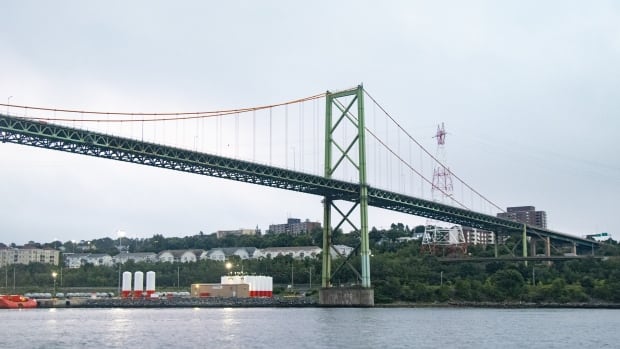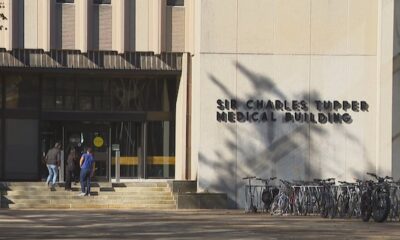Top Stories
Future of MacKay Bridge Uncertain as Repairs Loom

The future of the A. Murray MacKay Bridge, a critical transportation link in Halifax, is in question as its structural integrity deteriorates. Opened in 1970, the bridge is showing signs of wear, prompting officials to anticipate an increase in repair work over the coming years. Tony Wright, chief executive officer of Halifax Harbour Bridges, has stated that maintenance will become more frequent as the bridge approaches the end of its intended lifespan.
Wright noted that the bridge was designed for a service life of 50 years, and with it now in year 55, the demand for maintenance is expected to rise significantly. “By 2035 or 2040, we anticipate the level of maintenance required to keep it operational will yield little value for money,” he said. As a result, decisions regarding whether to replace or refurbish the bridge will need careful consideration.
The bridge typically accommodates up to 115,000 vehicles daily, with more than half of that traffic using the MacKay Bridge. This includes a significant amount of commercial traffic, which exacerbates wear and tear. Since the tolls were removed on March 17, 2023, experts have warned that this could lead to increased traffic volumes. Wright mentioned that while traffic data is still being validated, the focus is on understanding the weight of vehicles crossing the bridge, as heavier loads can significantly impact structural integrity.
Wright’s comments were echoed by Kathryn Morse, a councillor for Halifax-Bedford Basin West, who serves on the bridge’s board of commissioners. She expressed her concerns regarding the potential for increased traffic and the urgency of developing long-term plans for the aging structure. “The bridges are the most critical piece of transportation infrastructure in the city,” Morse stated. She emphasized the need for clear data to inform future planning, especially regarding related projects such as the Windsor Street exchange.
Options for the Bridge’s Future
A 2018 feasibility study conducted by the engineering consulting firm COWI North America evaluated various scenarios for extending the bridge’s use or constructing a new structure. The study recommended building a new bridge slightly north of the existing one, featuring six lanes for vehicles and two lanes for active transportation. However, Wright cautioned that this recommendation was preliminary and lacked detailed analysis.
Subsequently, the Aecon Group was commissioned to conduct a more in-depth examination of refurbishment options. “We are exploring how to rehabilitate the deck and what the requirements would be for a major lift,” Wright explained. The complexity of potential upgrades is significant, with necessary fortifications to the main towers and foundations to support increased loads. Current estimates place refurbishment costs between $600 million and $700 million, while a new bridge could cost twice as much. Wright cautioned against prematurely estimating the costs, emphasizing that traffic capacity requirements will heavily influence final figures.
Additionally, tunnel options have been considered, which would involve a route starting near Highway 111 and extending to the Windsor Street exchange. Such a project would be considerably longer and more expensive than bridge alternatives, potentially five times the cost of surface constructions.
Challenges Ahead
Any choice regarding the bridge’s future will involve extensive planning and procurement, which could take three to five years, followed by construction that may last another six to ten years. Wright highlighted the urgency of beginning this process soon to avoid a situation where they are forced to undertake unplanned rehabilitation efforts as the bridge’s condition continues to decline.
“We are trying to avoid a scenario where we are not prepared for necessary repairs,” he said. The bridge is expected to undergo maintenance closures over at least four weekends in 2025, which will impact traffic and necessitate further discussion about the bridge’s long-term future.
The uncertainty surrounding the A. Murray MacKay Bridge reflects broader challenges in managing aging infrastructure. As Halifax continues to grow, the decisions made about this vital transportation link will significantly affect the region’s connectivity and economic vitality in the years to come.
-

 World3 months ago
World3 months agoScientists Unearth Ancient Antarctic Ice to Unlock Climate Secrets
-

 Entertainment3 months ago
Entertainment3 months agoTrump and McCormick to Announce $70 Billion Energy Investments
-

 Science3 months ago
Science3 months agoFour Astronauts Return to Earth After International Space Station Mission
-

 Lifestyle3 months ago
Lifestyle3 months agoTransLink Launches Food Truck Program to Boost Revenue in Vancouver
-

 Technology2 months ago
Technology2 months agoApple Notes Enhances Functionality with Markdown Support in macOS 26
-

 Top Stories7 days ago
Top Stories7 days agoUrgent Update: Fatal Crash on Highway 99 Claims Life of Pitt Meadows Man
-

 Sports3 months ago
Sports3 months agoSearch Underway for Missing Hunter Amid Hokkaido Bear Emergency
-

 Politics2 months ago
Politics2 months agoUkrainian Tennis Star Elina Svitolina Faces Death Threats Online
-

 Technology3 months ago
Technology3 months agoFrosthaven Launches Early Access on July 31, 2025
-

 Politics3 months ago
Politics3 months agoCarney Engages First Nations Leaders at Development Law Summit
-

 Entertainment3 months ago
Entertainment3 months agoCalgary Theatre Troupe Revives Magic at Winnipeg Fringe Festival
-

 Politics1 week ago
Politics1 week agoShutdown Reflects Democratic Struggles Amid Economic Concerns





















